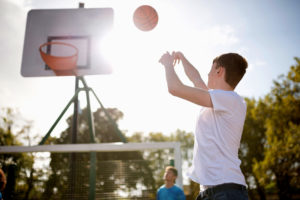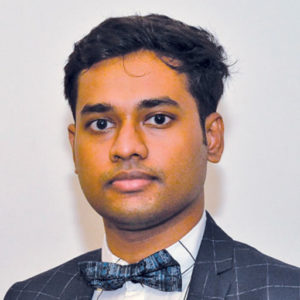January 3, 2023
By Dr. Pavan K. Verkicharla and Mr. Swapnil Thakur
With the recent development in digital technologies and the younger generation being more inclined to use technology, the future seems promising for technologies such as at-home or wearable light therapies. But for now, advocating for children to spend more time in natural outdoor environments appears to be an effective and cost-effective way to keep myopia’s growing incidence in check.
 As digital technology has evolved and the demand for academic excellence/higher education has become more pressing, children globally are now less engaged in outdoor activities compared to their counterparts from a few decades ago. This alteration in behavior towards a more indoor-centric lifestyle with less outdoor light exposure has consistently been reported to be associated with an increasing prevalence of myopia. The notion of outdoor light exposure being protective against myopia development has been around since the late 18th century,1 suggesting “insistence of out-of-door exercises — should be followed out with particular stringency” for an individual at risk of developing myopia.
As digital technology has evolved and the demand for academic excellence/higher education has become more pressing, children globally are now less engaged in outdoor activities compared to their counterparts from a few decades ago. This alteration in behavior towards a more indoor-centric lifestyle with less outdoor light exposure has consistently been reported to be associated with an increasing prevalence of myopia. The notion of outdoor light exposure being protective against myopia development has been around since the late 18th century,1 suggesting “insistence of out-of-door exercises — should be followed out with particular stringency” for an individual at risk of developing myopia.
Many factors, including high-intensity ambient light/illumination levels, spectral content of light exposure, reduced peripheral retinal defocus due to equal dioptric field, increased depth of focus due to pupil miosis, relaxed accommodation, and increased amount of high spatial frequency, have been attributed to the protective effect of outdoor light. Most recent hypotheses also indicate possible associations with light exposure, circadian rhythm, melatonin level, and ocular growth.
Light Exposure and Eye Health
Considering these many factors, recent investigations have mainly focused on the effect of light intensity and spectral content on ocular growth. Short-term exposure to moderate (500 lux) to high-intensity light (1000 lux) was shown to significantly slow axial elongation in humans.2 In another investigation, one-hour exposure to blue light resulted in a relative decrease in axial length compared to a substantial increase in axial length following long-wavelength light exposure. The response remained unchanged under the presence of hyperopic defocus.3 Similarly, violet light exposure was also shown to be protective against myopia.4
Evidence from several clinical trials indicates that repeated low-level red-light exposure (RLRL) has significantly controlled myopia progression in children receiving the therapy compared to controls.5 Additionally, daily morning light therapy using a wearable light therapy device appears to be a promising non-invasive treatment strategy to control ocular growth.6 While these concepts and recent investigations are encouraging, further work and validation are needed before these are translated into clinical recommendations.
Indoors versus Outdoors
The intensity and the spectral content of ambient light vary significantly across different outdoor and indoor locations. With different outdoor locations, the light intensity levels can be quite different (10 times higher in an “open playground” with ≈ 9000 lux in comparison to a location “within four buildings” with ≈ 11 lux levels). At a few outdoor locations, such as beneath a “canopy,” or in space enclosed “between three tall buildings” and “within four tall buildings” light intensity was similar to that observed in the indoor locations (<1000 lux).7
A recent study from the LV Prasad Myopia Research lab investigated the variation in the spectral content of light at various indoor and outdoor locations. This study demonstrated that the pattern and the relative percentage composition of short, middle, and long wavelengths were similar in both the outdoor and indoor locations. However, the energy level of the light throughout the range of wavelengths (indicated by spectral power distribution) was higher in the outdoor location in comparison to indoors.8 Based on these findings, it is evident that “all outdoor locations are not truly outdoors” in terms of light intensity, and eye care practitioners should always provide clear guidelines while recommending outdoor activities as a part of myopia management.
The benefit of outdoor time in delaying or preventing the onset of myopia has been conclusively demonstrated through numerous studies. Still, paradoxically its role in slowing down the progression of myopia has remained elusive so far. A recent systematic review by Dhakal et al. (2022) provides a comprehensive evidence map on the role of outdoor light exposure and reported that in children who are already myopic, the effect of outdoor light exposure seems clinically ineffective in controlling myopia progression (annual reduction in mean myopia progression ranged from 0.13 to 0.17 D).9 Nevertheless, it is always advisable to recommend more time in outdoor light exposure to a child irrespective of their refractive status because of its additional general health benefits. There is an additional effect of less time on near work. Does performing near work in an outdoor environment still result in accelerated axial elongation? Our recent lab-based experiment indicated that performing near work while being in an outdoor location (>10,000 lux) for 15 minutes resulted in a considerable increase in axial length compared to a distant viewing task in an outdoor area. This finding supports the belief that when children are outside, they should be encouraged to engage in activities/sports that require distance viewing rather than remaining attached to their digital devices or any near work activities.
Guidelines for Outdoor Time
Despite extensive research in the field of outdoor light exposure and myopia, there remain many questions that continue to be heavily debated. For example, what factors are responsible for outdoor light exposure’s protective impact? Is it light’s energy level/intensity, spectral content, or something else? When is the best time of day (morning versus evening) to engage in outdoor activities? What effect will increasing indoor illumination in classrooms have on the onset of myopia?
Currently, the recommendations related to outdoor activities or increasing time outdoors for myopia management seem simplistic, with no definitive guidelines. It might be helpful to add recommendations that improve the protective effect, such as the type of location (preferably open playgrounds/parks), time (during the day), and duration of outdoor activities (about two hours per day). With the recent development in digital technologies and the younger generation being more inclined to use technology, the future seems promising for technologies such as at-home or wearable light therapies. But for now, advocating for children to spend more time in natural outdoor environments appears to be an effective and cost-effective way to keep myopia’s growing prevalence in check.
 |
Dr. Pavan Verkicharla, BS Opt, PhD, is a scientist researching on myopia and heads both the myopia research lab and myopia centre at the L V Prasad Eye Institute, India. Pavan is also a collaborator of BHVI working on myopia-related projects. |
 |
Mr. Swapnil Thakur, BS Opt, PGDOVS, is a research optometrist in the myopia research lab, L V Prasad Eye Institute, India. |
Reference:
- Fuchs E, Duane A. Text-book of Ophthalmology: JB Lippincott; 1908.
- Chakraborty R, Baranton K, Spiegel D, Lacan P, Guillon M, Anstice N, et al. Effects of mild-and moderate-intensity illumination on axial length and choroidal thickness in young adults. Investigative Ophthalmology & Visual Science. 2021;62(8):1336-.
- Thakur S, Dhakal R, Verkicharla PK. Short-Term Exposure to Blue Light Shows an Inhibitory Effect on Axial Elongation in Human Eyes Independent of Defocus. Invest Ophthalmol Vis Sci. 2021;62(15):22.
- Torii H, Mori K, Okano T, Kondo S, Yang H-Y, Yotsukura E, et al. Short-Term Exposure to Violet Light Emitted from Eyeglass Frames in Myopic Children: A Randomized Pilot Clinical Trial. Journal of clinical medicine. 2022;11(20):6000.
- Jiang Y, Zhu Z, Tan X, Kong X, Zhong H, Zhang J, et al. Effect of repeated low-level red-light therapy for myopia control in children: a multicenter randomized controlled trial. Ophthalmology. 2022;129(5):509-19.
- Read SA, Pieterse EC, Alonso-Caneiro D, Bormann R, Hong S, Lo CH, et al. Daily morning light therapy is associated with an increase in choroidal thickness in healthy young adults. Sci Rep. 2018;8(1):8200.
- Bhandary SK, Dhakal R, Sanghavi V, Verkicharla PK. Ambient light level varies with different locations and environmental conditions: Potential to impact myopia. Plos one. 2021;16(7):e0254027.
- Dhakal R, Huntjens B, Shah R, Lawrenson J, Verkicharla PK. Does the spectral composition of an ambient light vary between indoors and outdoors “in myopia perspective”? Investigative Ophthalmology & Visual Science. 2022;63(7):1890–A0019-1890–A0019.
- Dhakal R, Shah R, Huntjens B, Verkicharla PK, Lawrenson JG. Time spent outdoors as an intervention for myopia prevention and control in children: an overview of systematic reviews. Ophthalmic and Physiological Optics. 2022;42(3):545-58.













